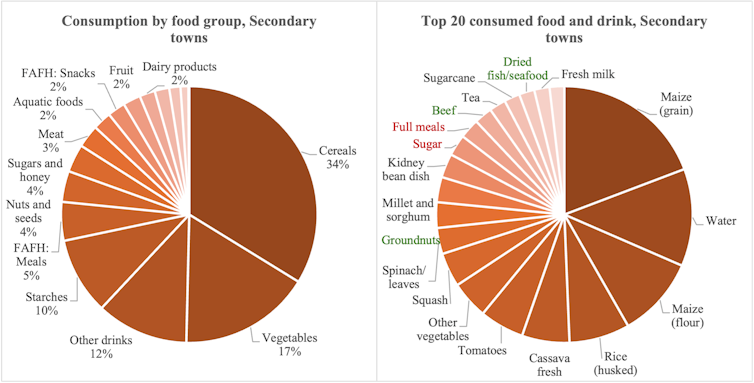Cities are growing faster in sub-Saharan Africa than in other regions, with annual urban population growth rates of around 4%, compared to the global average of 1.5%.
Across the continent, the share of cities in the total population is expected to increase to 50% by 2030 and 60% by 2050.
Urbanization is associated with lifestyle changes, including less physical activity and fewer labor-intensive jobs. This is often accompanied by increased intake of high-calorie fast foods, snacks, and sugary drinks.
This combination is contributing to the rise in obesity in cities in low- and middle-income countries. At the same time, nutritional deficiencies and micronutrient deficiencies remain problems.
In Tanzania, approximately 37% of the population lives in urban areas. Dar es Salaam is home to approximately 5.3 million people, or 28% of the city’s population.
My latest research as an agricultural economist focused on nutrition examines differences in diet quality between rural areas, second-largest cities, and the commercial capital of Dar es Salaam.
What people eat varies greatly depending on where they live. Public health campaigns to improve nutrition need to target these areas differently.
food diary
Using food diary data recorded by 1,506 households over a two-week period, we calculated calorie, macro and micronutrient intakes and compared them to recommended requirements for healthy living.
Data were collected in five regions of Tanzania, each representing a different ecological and economic zone. In our sample, 988 households live in rural areas, 304 in urban areas, and 214 in Dar es Salaam.
In addition to food diaries, our data also included information on household characteristics and socio-economic status. This included details about education level, assets, and food production.
Is it homemade or highly processed?
We found that people living in rural areas suffer from the most severe deficiencies.
This was caused by not eating enough food.
Although most food was home grown and provided beneficial nutrients, diets were not diverse enough to provide all the nutrients needed for a healthy life.
In contrast, residents of Dar es Salaam also had unhealthy diets, but for very different reasons.
They relied heavily on processed cereal products and ready-made foods. This means you’re not getting enough fiber and micronutrients, and you’re also consuming too much saturated fat and sugar.
By comparison, households in secondary cities with a population of less than 500,000 people had the healthiest diets of the three cities.
Residents still produce some of their own food, and at the same time have increased access to markets, more food options to diversify their diets, and more income to withstand this diversity.
calories, nutrients, or lack thereof
1.) Rural households mainly consumed starches, grains, vegetables, and fruits, accounting for 29%, 21%, 12%, and 7% of their diets, respectively.
The most consumed food items in rural areas were plantains, maize, cassava, sweet potatoes, and spinach.

Although these diets are considered healthy, many still faced severe deficiencies. Approximately 48% of households did not meet the recommended daily calorie intake. Between 40% and 80% of households in these regions were not getting enough vitamins and minerals important for physical and mental development, such as folic acid, vitamin B12, calcium, iron, and zinc.
Many of these nutrients were found in animal foods, which were a small proportion of rural diets.
2.) In secondary cities, corn, rice, cassava, tomatoes, and pumpkins were most frequently eaten. In terms of quantity, these households tend to consume more food and have lower levels of nutritional deficiencies than rural areas.
Approximately 26% of households did not meet the recommended calorie intake, which was significantly improved compared to rural areas.

Additional intake of foods such as peanuts, beef, and dried aquatic foods further improved the nutritional adequacy of the diet.
Read more: The missing piece in fighting Africa’s malnutrition problem
These households consumed about 20% more calories, fat, and protein than they would need for a healthy diet. Thiamine, niacin, vitamin B12, magnesium, iron, and zinc intake also increased by 15% to 45% compared to the rural diet.
3.) When comparing rural areas and towns to megacities like Dar es Salaam, dietary patterns have changed significantly. Cereals, including highly processed cereal products such as bread and pasta, made up 25% of the city’s diet.
The next most common type of meal is a complete meal purchased outside the home. Vegetables only made up about 8.5% of the diet. Consumption of snack foods such as chapattis and donuts was also high.

These households were consuming too much fat, saturated fat, and sugar. They had inadequate intakes of fibre, thiamin, folate, key vitamins such as vitamins C and E, and minerals such as calcium and potassium, putting them at risk of obesity and micronutrient deficiencies.
next step
Deficiencies in essential nutrients have a variety of health ramifications, including decreased cognitive function, fatigue, and increased illness and infection.
At the same time, overconsumption of potentially harmful food substances such as fat and sugar can lead to health risks such as obesity, diabetes, and cardiovascular disease.
The findings highlight the need for different approaches to address nutritional intake and tackle issues such as rising obesity rates. One size does not fit all.
Read more: African countries need to embrace good food as good medicine

